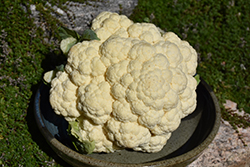Casper Cauliflower
Brassica oleracea var. botrytis 'Casper'
Height: 18 inches
Spacing: 12 inches
Sunlight:
![]()
Hardiness Zone: (annual)
Description:
A wonderful variety with excellent self coverage; produces dense, domed white heads with large, vigorous leaves; delicious and crunchy, ideal for pickling, roasting, freezing or eating with dip; ideal for late summer and fall harvests
Edible Qualities
Casper Cauliflower is an annual vegetable plant that is commonly grown for its edible qualities. The round green tightly-wrapped heads of foliage are typically harvested when mature. The heads have a delicious taste and a crunchy texture.
The heads are most often used in the following ways:
- Fresh Eating
- Eating When Cooked/Prepared
- Cooking
- Pickling
- Freezing
Planting & Growing
Casper Cauliflower will grow to be about 18 inches tall at maturity, with a spread of 12 inches. When planted in rows, individual plants should be spaced approximately 12 inches apart. This fast-growing vegetable plant is an annual, which means that it will grow for one season in your garden and then die after producing a crop.
This plant is typically grown in a designated vegetable garden. It should only be grown in full sunlight. It does best in average to evenly moist conditions, but will not tolerate standing water. This plant should not require much in the way of fertilizing once established, although it may appreciate a shot of general-purpose fertilizer from time to time early in the growing season. It is not particular as to soil pH, but grows best in rich soils. It is somewhat tolerant of urban pollution. Consider applying a thick mulch around the root zone over the growing season to conserve soil moisture. This is a selected variety of a species not originally from North America.
Casper Cauliflower is a good choice for the vegetable garden, but it is also well-suited for use in outdoor pots and containers. It is often used as a 'filler' in the 'spiller-thriller-filler' container combination, providing the canvas against which the thriller plants stand out. Note that when growing plants in outdoor containers and baskets, they may require more frequent waterings than they would in the yard or garden.


